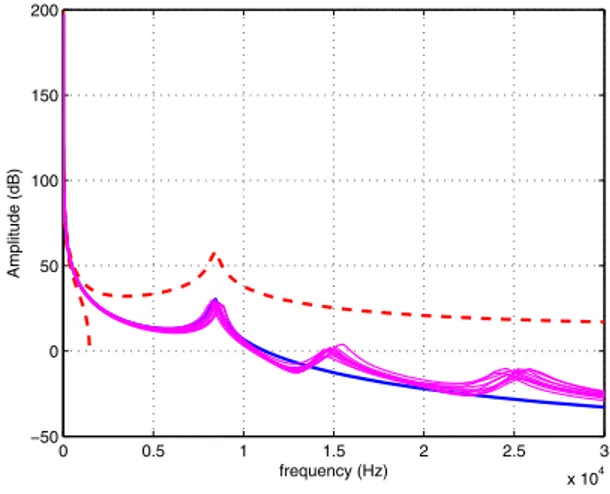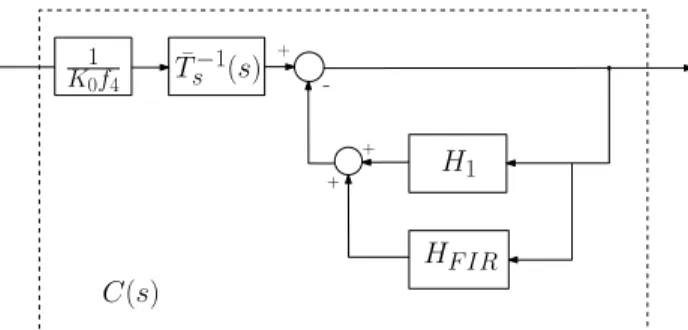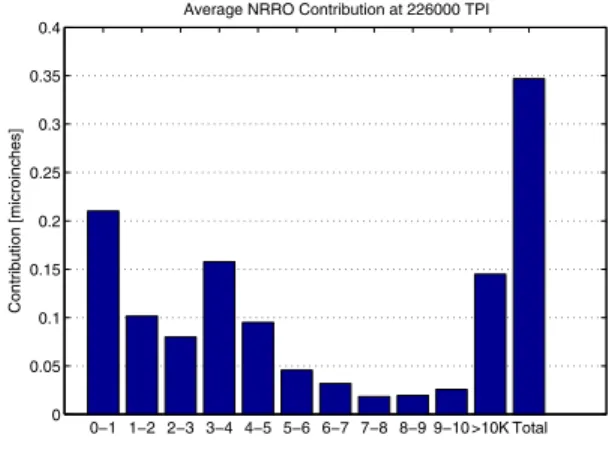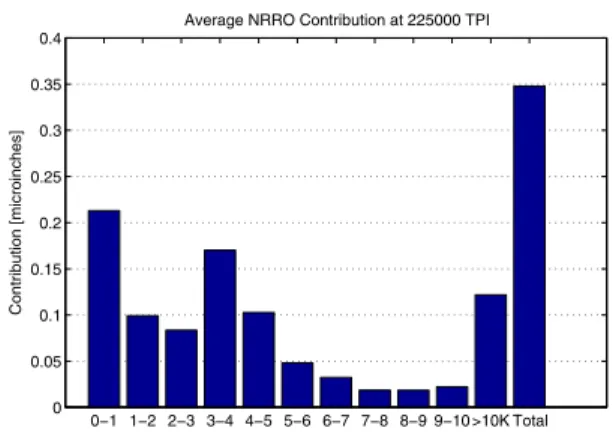On the robust controller design for Hard Disk Drive servo systems with
time delays
Peng Yan
1, Hitay ¨
Ozbay
2Abstract— Due to the existence of various sources of delays, the dynamical model of HDD (Hard Disk Drive) servo systems is actually infinite dimensional, although most of the control algorithms simplified the model with Pad´e expansions or other finite dimensional approximations. In this paper, a robust loop shaping algorithm is developed for the HDD model with delays by using an H∞ synthesis approach for infinite dimensional systems. The H∞ controller is derived with a structure of an internal feedback loop including an FIR (Finite Impulse Response) filter and an IIR (Infinite Impulse Response) filter, which facilitates non-fragile implementations. Comparisons to other robust control methods are given and the advantages of this approach are demonstrated in terms of improvement of TMR (track misregistration) and tracking TPI (Track-per-Inch) capability.
I. INTRODUCTION
The rapid growth of research on nano-precision mecha-tronics and the immense demands of HDD storage with various application have imposed many new challenges on servo technologies. There have been considerable research works that address important control issues inherited in this area, see [1], [3], and [4]. In [22] a robust µ-synthesis approach is introduced for the head positioning of a VCM (Voice Coil Motor) actuator in HDD. The robust loop shape problem is also discussed in [8], where a dual stage actuation architecture is adopted. Track-seeking is also an important topic inviting considerable studies, for example, the well-known PTOS (Proximate Time Optimal Seek) control ap-proach discussed in [16], [17], and more recent result on the use of variable structure observer in seeking control [15]. Advanced control algorithms are not only used in servo operations for data access, but also in the process of writing servo patterns during HDD manufacturing, see for example [20], [5], [14].
Among the abundant research results on HDD servo algo-rithms, one of the central topics is the robust loop shaping for HDD servo systems, which determines the servo bandwidth, attenuations of disturbance, and transient behaviors during seek settling. Robust control theory has been widely inves-tigated for HDD [22], [8], as well as other nano-positioning applications [9], [18], [10], [25], where standard H∞ con-trol algorithms and µ-synthesis [24] have been successfully developed. It is worth noting that the dynamical model of 1 School of Automation Science and Electrical Engineering, Beihang
University, Beijing, 100191, China; also with Key Laboratory of High-efficiency and Clean Mechanical Manufacturing, Ministry of Education, School of Mechanical Engineering, Shandong University, Jinan, Shandong, 250061, P. R. ChinaPengYan2007@gmail.com
2Bilkent University, Electrical and Electronics Engineering Department,
06800, Bilkent, Ankara, Turkeyhitay@bilkent.edu.tr
HDD servo systems is actually infinite dimensional due to the existence of various sources of delays [21], although most of the control algorithms simplified the model with Pad´e expansion or other finite dimensional approximations. Therefore two important questions remain open in this area: 1) is it possible to synthesize robustH∞ controllers for the infinite dimensional HDD model directly, and 2) what are the advantages of the direct approach, compared to the existing approximation methods?
In this paper, the time delay model of HDD servo systems is analyzed with uncertainties and formulated to a mixed sensitivity optimization problem for robust control. By using theH∞ control theory for infinite dimensional systems [6], the optimalH∞ performance can be numerically computed and an explicit form of the optimal H∞ controller can be developed. Based on coprime-inner/outer factorization, we can eliminate the unstable pole-zero cancelations in the
H∞ controller and generate the controller structure with an internal feedback loop including an FIR (Finite Impulse Response) filter and an IIR (Infinite Impulse Response) filter, [7], [12], [23], which facilitates a non-fragile implementation of the robust servo controller. Another important contribution of the present paper is the comparisons to existing robust control methods, which demonstrate significant improvement of TMR and tracking TPI (Track-per-Inch) capability.
The rest of the paper is organized as follows: in Section II, we describe the HDD servo model with time delays and uncertainties. In Section III, we discuss the mixed sensitivity optimization problem for the SISO time delay systems, and the non-fragile structure for controller implementations. A design case is studied in details in IV, where comparisons are also provided with existing robust control approaches of Pad´e approximations. Tracking TPI capabilities and TMR analysis are discussed in Section V to illustrate the advantages of the proposed design, followed by conclusions in Section VI.
II. MODELING OF HDD SERVO SYSTEMS A modern HDD can be considered as an ultra-high pre-cision mechatronics device. The dynamics of a single stage HDD with a VCM actuator can be modeled as:
P (s) = KDCe
−hs
s2 Ts(s)Th(s), (1)
where KDC is the actuator DC gain, h the total time delay from various sources such as PWM filters, power amplifiers, actuator delays, and Ts(s) the first translational
2013 European Control Conference (ECC) July 17-19, 2013, Zürich, Switzerland.
101 102 103 104 −50 0 50 100 150 Amplitude (dB) 101 102 103 104 −600 −400 −200 0 200 frequency (Hz) Phase (degree)
Fig. 1. Nominal plant and actual plants with uncertainties.
mode (system mode):
Ts(s) = As(s) Bs(s) =s 2+ 2ξ z,0ωnz,0s + ω 2 nz,0 s2+ 2ξ p,0ωnp,0s + ω 2 np,0 , (2)
where ξz,0 and ωnz,0 are the damping ratio and natural frequency of the zeros of the system mode, and ξp,0 and
ωnp,0 the damping ratio and natural frequency of the poles.
Note that Ts(s) is stable, biproper and minimum phase, i.e.,
Ts(s)∈ H∞ and Ts−1(s)∈ H∞, which is usually guaran-teed by the mechanical design of HSA (Head Suspension Assembly). All the high frequency resonant modes can be modeled by Th(s): Tm(s) = N ∏ i=1 1 ω2 nz,is 2+ 2 ξz,i ωnz,is + 1 1 ω2 np,is 2+ 2 ξp,i ωnp,is + 1 , (3)
where ξz,i, ξp,i, ωnz,i and ωnp,i are the damping ratios and natural frequencies of the ith resonant mode.
We define the nominal model of (1) as:
P0(s) = K0e−hs s2 T¯s(s), (4) where ¯ Ts(s) = ¯ As(s) ¯ Bs(s) = s2+ 2 ¯ξz,0ω¯nz,0s + ¯ω 2 nz,0 s2+ 2 ¯ξ p,0ω¯np,0s + ¯ω 2 np,0 . (5)
As depicted in Figure 1, the nominal plant P0(s) is illustrated by the thick blue line and the actual plant with various uncertainties can be illustrated by the thin magenta lines. Now that the multiplicative uncertainties can be written as:
∆Pm(s) = P (s)− P0(s)
P0(s)
= A¯s(s) ¯Bs(s)
As(s)Bs(s)
Tm(s)− 1. (6)
We denote the multiplicative uncertainty bound W2(s) with
|∆Pm(s)|s=jω ≤ |W2(s)|s=jω, which can be used to de-scribe the the upper and lower bounds of the plant variations by |P0(jω)| ± |P0(jω)W2(jω)| (see the the dash lines in Figure 2). 0 0.5 1 1.5 2 2.5 3 x 104 −50 0 50 100 150 200 frequency (Hz) Amplitude (dB)
Fig. 2. Plant model and uncertainty bounds.
III. MIXED SENSITIVITY OPTIMIZATION FOR INFINITE DIMENSIONAL SYSTEMS
Various robust control algorithms has been widely dis-cussed for HDD servo design (see [11], [13], [8], [21], to cite just a few contributions). An applicableH∞control method in servo loop shaping is mixed sensitivity optimization, where the nominal performance (determined by performance weighting W1(s)) and robust stability (determined by uncer-tainty weighting W2(s)) can be optimized simultaneously:
inf Cstab.P0 [ W1(s)(1 + P0(s)C(s))−1 W2(s)P0(s)C(s)(1 + P0(s)C(s))−1 ] ∞ (7) Note that standard H∞ control theory, as readily imple-mented in the robust control toolbox of Matlab, cannot be applied due to the existence of time delays in P0(s). In what follows, we would like to investigate the mixed sensitivity optimization problem (7) using the robust control theory for infinite dimensional systems developed in [6], [19] based on frequency domain techniques. For time delay systems considered here state-space based design methods are also available, [12], [23]. First, define ˜ P0(s) = P0(s)∗ ¯Ts−1(s)≈ K0e−hs (s + ϵ)2 ˜ C(s) = C(s)∗ ¯Ts(s), (8)
where ϵ > 0 is sufficient small. With this, the original H∞ optimization (7) can be written as:
inf ˜ Cstab. ˜P0 [ W1(s)(1 + ˜P0(s) ˜C(s))−1 W2(s) ˜P0(s) ˜C(s)(1 + ˜P0(s) ˜C(s))−1 ] ∞ , (9) where the optimalH∞controller, denoted by ˜Copt(s), yields:
[ W1(s)(1 + ˜P0(s) ˜Copt(s))−1 W2(s) ˜P0(s) ˜Copt(s)(1 + ˜P0(s) ˜Copt(s))−1 ] ∞ = γo.
We define W1(s) = K1/s2 to meet the design specifica-tion of HDD servo loop on low frequency roll-off around
40dB/dec for disturbance attenuations. The multiplicative uncertainty weight is chosen as a second order polynomial
W2(s) = a + bs + cs2 to accommodate model uncertainties (see Figure 2). Observe that ˜P0(s) admits the coprime inner/outer factorization ˜P0(s) = mnNo, where mn =
e−hs∈ H∞(C+) is inner and No= K0/(s+ϵ)2∈ H∞(C+) is outer.
Applying the formulae of [6], [19], the optimal solution to (9) is given in the form:
˜ Copt(s) = 1 K0 Eγo(s) s2 F γo(s) L(s) 1 + e−hsFγo(s) L(s) (10) where Eγo(s) = nE(s) dE(s) = K2 1− γo2s4 γ2 os4 Fγo(s) = nF (s) dF (s) = s2 f4s4+ f3s3+ f2s2+ f1s + f0 (11) with coefficients f0, . . . , f4 depending on γo
L(s) = nL(s)
dL(s) =
1 + aLs
1− aLs
with aL and γo are determined from two interpolation conditions, see [19].
A. Controller Structure and Implementation
It is noticed that theH∞controller (10) has unstable zero-pole cancelations due to interpolation conditions. However the exact cancelations for the factorization terms are not possible because of the infinite dimensional term of the time delay in the controller [7], [12], [23]. We would like to rearrange the terms in the controller to eliminate the unstable zero-pole cancelations such that the above controller structure is implementable.
In fact, ˜Copt(s) can be rewritten as: ˜ Copt(s) = 1 K0f4 ( 1 1 + H(s) ) , (12) where H(s) = H1(s) + HF IR(s), (13) with H1(s) = QH1 1 + aLs , QH1 = 2 f4 dF (−1/aL) nE(−1/aL) , (14)
It can be further shown that HF IR(s) is an FIR filter defined as: HF IR(s) =L{hF IR(t)} (15) with hF IR(t) = { C0eA0tB0 0 0 t > h (16) where C0(sI− A0)−1B0= h0(s) (s + 1/aL)nE(s) , and h0(s) = 1 f4 (1/aL− s) dF (s)
− (1/aL+ s) nE(s)− QH1nE(s).
1 K0f4 T¯s−1(s) H1 HF IR + C(s) + +
-Fig. 3. Controller structure.
From (8), (12) and (13), we can derive the optimal H∞ controller Copt(s) = 1 K0f4 ¯ Ts−1(s) ( 1 1 + H1(s) + HF IR(s) ) , (17)
which has the structure as depicted in Figure 3. It is worth noting that the controller structure (17) facilitates non-fragile digital implementations due to the FIR feature of HF IR(s) and the low order representation of H1(s).
B. Pad´e Approximation Methods
Most of the existing results on HDD servo loop shaping employ low order Pad´e approximations (18) to simplify the problem to a finite dimensional system, with which the closed form solutions ofH∞ controllers to the problem (7) can be synthesized by standard 2-block H∞ optimization [24]. e−hs≈ Thm(s) := 1− k1s + k2s 2+· · · ± k msm 1 + k1s + k2s2+· · · + kmsm , (18) where Tm h (s) is the m
th order Pad´e approximation. Now that an important open problem is the conservative-ness of this method using various Pad´e approximations and how they are compared with the direct method discussed above. For this purpose, we consider the mixed sensitivity optimization (7) by Pad´e approximations with e−hs ≈
Thm(s), m = 1, 2, 3, respectively. We denote P0m(s) = K0 s2T m h (s) ¯Ts(s), , m = 1, 2, 3 (19) and ˜ W1(s) := K1 (s + ϵ1)2 ≈ W1(s), ϵ1> 0 ˜ W2(s) := a + bs + cs2 (ϵ2s + 1)2 ≈ W 2(s), ϵ2> 0. A standard mixed sensitivity optimization problem can for-mulated for finite dimensional models P0m(s), m = 1, 2, 3:
inf Cmstab.Pm 0 [ W˜1(1 + P0mC m)−1 ˜ W2P0mCm(1 + P0mCm)−1 ] ∞ , m = 1, 2, 3. (20) Note that low order Pad´e approximations result in inaccu-racies at high frequency, while higher order approximations lead to high order controller dynamics and undesired ze-roes/poles which could cause transient problem. We will use
K0 h ξ¯z,0 ξ¯p,0 ω¯nz,0 ω¯np,0 5.2269× 108 6× 10−5 0.99 0.018 1.244× 105 5.29× 104 ϵ K1 a b c 0.01 2× 107 0.3125 9.4211× 10−6 8.772× 10−11 TABLE I MODEL COEFFICIENTS. 0 0.2 0.4 0.6 0.8 1 x 10−4 −5 −4.5 −4 −3.5 −3 −2.5 −2 −1.5 −1 −0.5 0x 10 −5 Time (second) FIR response
Fig. 4. Time response of FIR HF IR(s).
a design example to compare the direct method for infinite dimensional systems and the Pad´e approximation methods.
IV. A DESIGN CASE STUDY
In this section, we apply the control algorithm derived in the above section to an industry design case, where an enterprize class 2.5-inch form factor HDD is considered. The HDD has 15kRP M rotation speed for high performance purpose, which requires challenging design specifications on the servo control system. The nominal plant model (4) and the weighting functions are defined in Table I. The nominal model (blue line) of the HDD VCM structures and the uncertainty bounds are depicted in Figure 2.
To begin with, we determine the optimalH∞performance
γo = 0.48336 using the computational procedure of [19]. That leads to the following numerical values for the compo-nents of the optimalH∞controller in Section III:
¯ Eγo(s) = n ¯E d ¯E = −0.2336 s4+ 4× 1014 0.2336 s4 , ¯ L(s) = n ¯L d ¯L = 1 + aLs 1− aLs , aL= 2.5124× 10−4, and f4 = 1.81× 10−10, f3 = 2.127× 10−5, f2 = 0.8467, f1 = 7294, f0 = 3.156× 107 in (11). From (13) to (17), we have the optimal H∞ controller written as (21) where the FIR term HF IR(s) is determined by (15) and (16), with time domain response depicted in Figure 4.
For comparison purpose, we also synthesize H∞ con-trollers based on (20) using various Pad´e approximations. As
103 104 105 −20 −15 −10 −5 0 5 10 Frequency (Hz) Sensitivity Magnitude (dB) direct method 1st order Pade 2nd order Pade 3rd order Pade
Fig. 5. Sensitivity comparisons.
depicted in Figure 5, the proposed direct method significantly improves the closed loop bandwidth compared to Pad´e approximation methods: 0 dB crossing occurs at 1701 Hz with the direct design, whereas the same occurs at 1565 Hz, 1517 Hz and 1549 Hz, for the 1st, 2nd and 3rd order Pad´e approximation based designs, respectively. The direct design has the added advantage of lower sensitivity peaking, see Table II.
Method Sensitivity Peak Peak Frequency
Direct 6.61 dB 5091 Hz
Pade 1 8.55 dB 4138 Hz
Pade 2 6.66 dB 4918 Hz
Pade 3 7.24 dB 4643 Hz
TABLE II
SENSITIVITY PEAK COMPARISONS
It is also obvious that the proposed controller has more attenuation for disturbances below 6 kHz due to lower sensitivity magnitude.
V. HDD TMR ANALYSIS
In this section, we would like to investigate the tracking TMR and tracking TPI capability of the designed servo loop, by applying the disturbances measured from the target HDD. In HDD industries, the major RRO (Repeatable Runout) components of PES (Position Error Signal) are usually treated separately. Therefore the TMR analysis is based on the NRRO components of PES data. Due to the industry-specific modulation/demodulation methods, it is usually very
Copt(s) = 10.57s 2+ 2.01× 104s + 2.96× 1010 s2+ 2.46× 105s + 1.55× 1010 ( 1 1 +s+3.984.4×10×105 3 + HF IR(s) ) , (21) 0−1 1−2 2−3 3−4 4−5 5−6 6−7 7−8 8−9 9−10 >10K Total 0 0.05 0.1 0.15 0.2 0.25 0.3 0.35 0.4 Contribution [microinches]
Average NRRO Contribution at 234000 TPI
Fig. 6. Frequency components of NRRO: the proposed method.
difficult to get industry PES data for academic research. Most of the existing research results are based on PES data from spin stand environments, which could not fully reflect the actual TMR for servo tracking. In the present paper, we use actual PES data collected from an industry partner.
Figure 6 shows the NRRO components (using 1k HZ frequency bins) with theH∞ controller proposed in present paper and similar NRRO spectrum plots are also provided for the case of 1st order, 2nd order, and 3rd orderPad´e approximation methods, respectively (as depcited in Fig-ures 7, 8, and 9). It is very clear that the NRRO disc modes from 2kHz to 5kHz are better attenuated with the proposed controller, which agrees well with the loop shape comparisons in Figure 5.
A more detailed comparison is given in Table III, where TMR statistics of Mean NRRO value and Mean+3σ NRRO are provided, with the corresponding tracking TPI capabili-ties. It is shown that 2ndorder and 3rd order Pad´e approxi-mation methods outperform 1st order one by more than 6% TPI improvement. But higher order Pad´e approximations will not help further. Note that major issues with higher order Pad´e approximations are 1) higher order controllers resulted from the models, and 2) undesired zeros/poles introduced by Pad´e approximations. As a matter of fact, a common practice in industry HDD servo control is still 1storder Pad´e approximation based method. The data in Table III clearly demonstrates the improvement using theH∞control method for infinite dimensional systems, developed in present paper, where more than 10% TPI improvement can be achieved.
VI. CONCLUDING REMARKS
In this paper, we have developed a robust control algo-rithm for HDD servo loop shaping, where the time delay of the model was treated as an infinite dimensional block directly, as opposite to the Pad´e approximation methods of existing results. The explicit form of theH∞controller was
0−1 1−2 2−3 3−4 4−5 5−6 6−7 7−8 8−9 9−10 >10K Total 0 0.05 0.1 0.15 0.2 0.25 0.3 0.35 0.4 Contribution [microinches]
Average NRRO Contribution at 212000 TPI
Fig. 7. Frequency components of NRRO: 1storder Pad´e approximation.
0−1 1−2 2−3 3−4 4−5 5−6 6−7 7−8 8−9 9−10 >10K Total 0 0.05 0.1 0.15 0.2 0.25 0.3 0.35 0.4 Contribution [microinches]
Average NRRO Contribution at 226000 TPI
Fig. 8. Frequency components of NRRO: 2ndorder Pad´e approximation.
provided and a internal feedback structure of the controller was also given, which consists of a low order IIR and an FIR. TMR analysis showed significant improvement using the proposed method, with more than 10% tracking TPI capability achieved.
REFERENCES
[1] Abramovitch, D., and Franklin, G., 2002. A brief history of disk drive control. IEEE Control Systems Magazine, 22(3), pp.28-42. [2] Boettcher, U., De Callafon, R. A., and Talke, F. E., 2010. “An
internal model-based tracking control for a class of uncertain linear time-varying systems”. In Journal of Advanced Mechanical Design,
Systems, and Manufacturing, 4(1), pp. 107–118.
[3] Chen, B., Lee, T., and Venkataramanan, V., 2006. Hard Disk Drive
Servo Systems. Advances in Industrial Control Series, Springer, New
York, NY.
[4] Devasia, S., Eleftheriou, E., and Moheimani, R., 2007. A survey of control issues in nano-positioning. IEEE Transactions on Control
Systems Technology, 15(5), pp. 802-823.
[5] Dong, F., and Tomizuka, M., 2009. “An iterative learning control for self-servo writing in hard disk drives usingL1 optimal control”.
In Proceedings of American Control Conference, St. Louis, Missouri, pp 240–245.
Methods NRRO: Mean (µinch) NRRO: Mean+3σ (µinch) TPI TPI Improvement
1storder Pad´e approximation method 0.37 0.54 212K N/A
2ndorder Pad´e approximation method 0.34 0.51 226K 6.60%
3rdorder Pad´e approximation method 0.34 0.51 225K 6.13%
Method of the present paper 0.33 0.49 234K 10.38%
TABLE III
COMPARISONS OFTMRANDTPICAPABILITIES.
0−1 1−2 2−3 3−4 4−5 5−6 6−7 7−8 8−9 9−10 >10K Total 0 0.05 0.1 0.15 0.2 0.25 0.3 0.35 0.4 Contribution [microinches]
Average NRRO Contribution at 225000 TPI
Fig. 9. Frequency components of NRRO: 3rdorder Pad´e approximation.
[6] Foias, C., ¨Ozbay, H., and Tannenbaum, A., 1996. Robust Control of
Infinite Dimensional Systems: Frequency Domain Methods. Lecture
Notes in Control and Information Sciences, vol. 209, Springer, Berlin. [7] Gumussoy, S., 2012. “Coprime-inner/outer factorization of SISO time-delay systems and FIR structure of their optimal H∞ controllers”. In International Journal of Robust and Nonlinear Control, 22(3), pp. 981–998.
[8] Huang, X., and Horowitz, R., 2005. “Robust controller design of a dual-stage disk drive servo system with an instrumented suspension”. In IEEE Transactions on Magnetics, 41(8), pp. 2406–2413. [9] Huang, X., Lee, J.-I., Ramakrishnan, N., Bedillion, M., and Chu, P.,
2010. Nano-positioning of an electromagnetic scanner with a MEMS capacitive sensor. Mechatronics, 20(1), pp. 27-34.
[10] Kim, K.-S., Lee, S.-H., and Chung, C.-C., 2011. “A survey of control issues in optical data storage systems”. In Proceedings of IFAC World
Congress, Milano, Italy, pp 854–868.
[11] Mamun, A. A., Guo, G., and Bi, C., 2007. Hard Disk Drive: Mechatronics and Control. Automation and control engineering, CRC
Press, Boca Raton, FL.
[12] Meinsma, G., Mirkin, L., and Zhong, Q.-C., 2002. “Control of systems with I/O delay via reduction to a one-block problem”. In IEEE
Transactions on Automatic Control, 47(11), pp. 1890–1895.
[13] Messner, W., and Ehrlich, R., 2001. “A tutorial on controls for disk drives”. In Proceedings of American Control Conference, Arlington,
Virginia, pp 408–420.
[14] Nie, J., and Horowitz, R., 2010. “Control design of concentric self-servo track writing systems for hard disk drives”. In Proceedings of
American Control Conference, Baltimore, MD, pp 2631–2640.
[15] Ohno, K., and Horowitz, R., 2005. A variable structure multirate state estimate for seeking control of HDDs. IEEE Transactions on
Control Systems Technology, 13A(2), pp.233-245.
[16] Pao, L., Franklin, G. F., 1993. “Proximate time-optimal control of third-order servomechanisms”. In IEEE Transactions on Automatic
Control, 38(4), pp. 560–580.
[17] Pao, L., Franklin, G. F., 1994. “The robustness of a proximate time-optional controller”. In IEEE Transactions on Automatic Control, 39(9), pp. 1963–1966.
[18] Sebastian, A., and Salapaka, S. M., 2005 “Design methodologies for robust nano-positioning”. In IEEE Transactions on Control Systems
Technology, 13(6), pp. 868–876.
[19] Toker, O., and ¨Ozbay, H., 1995. “H∞ optimal and suboptimal
con-trollers for infinite dimensional SISO plangts”. In IEEE Transactions
on Automatic Control, 40(4), pp. 751–755.
[20] Wu, S., and Tomizuka, M., 2008. “An iterative learning control design for self-servo writing in hard disk drives”. In Proceedings of IFAC
World Congress, Seoul, Korea, pp 839–844.
[21] Yan, P., Mckenzie, L., Hanson, R., Lyle, T., Pollock, B., and Mathur, P., 2008. “Servo systems design for low sample rate disk drive systems”. In Proceedings of the 18th Annual ASME Conference on Information
Storage and Processing Systems, Santa Clara, CA, pp. SCT–B3.
[22] Young, P. M., Morris, J. C., and Ho, H. T., 2006. “µ-synthesis control with PI augmentation”. In Proceedings of the American Control
Conference, Minneapolis, MN, pp 1297–1302.
[23] Zhong, Q.-C., 2006. Robust Control of Time-delay Systems. Springer-Verlag, London.
[24] Zhou, K., Glover, K., and Doyle, J. C., 1995. Robust and Optimal
Control. Prentice-Hall, Englewood Cliffs, NJ.
[25] Zou, Q., Leang, K. K., Sadoun, E., and Reed, M. J, 2004. Control issues in high-speed AFM for biological applications: collagen imaging example. Asian Journal of Control, 6(2), pp.164-178.




